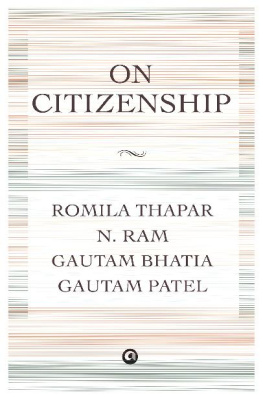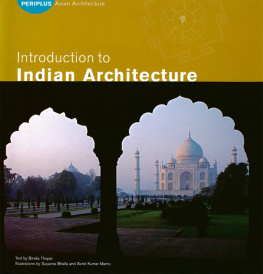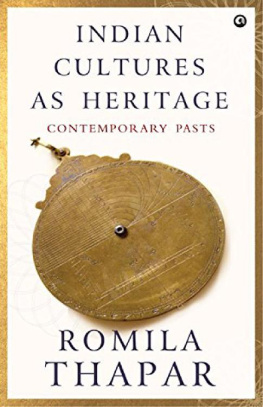PENGUIN BOOKS
A HISTORY OF INDIA
VOLUME ONE
Romila Thapar belongs to a Punjabi family and spent her early years in various parts of India. She took her first degree from the Punjab University and her doctorate at London University in 1958. She was a Lecturer in the Ancient History of South Asia at the School of Oriental and African Studies, University of London, subsequently a Reader at Delhi University, and in 1970 was appointed to the Chair in Ancient Indian History at the Jawaharlal Nehru University in New Delhi, where she is now Emeritus Professor of History. She is an Honorary Fellow of Lady Margaret Hall, Oxford, and has been a Distinguished Visiting Professor at Cornell University and at the University of Pennsylvania and has frequently lectured at the Collge de France. In 1983 she was elected General President of the Indian History Congress. In 1999 she was elected a Corresponding Fellow of the British Academy.
Field research linked to a project in Buddhist cave sites took her to China in 1957, and this included the site of Tun Huang in the Gobi Desert. Since then she has travelled extensively, visiting sites in South Asia. She has lectured on early South Asian history at a large number of universities in various parts of the world.
Among her other publications are a study of the Mauryan emperor Ashoka in Aoka and the Decline of the Mauryas; a collection of papers, Ancient Indian Social History: Some Interpretations; three others, From Lineage to State, Time as a Metaphor of History: Early India and Interpreting Early India, published in an omnibus edition entitled History and Beyond; an essay in literature and history, Sakuntala: Texts, Readings, Histories; two lectures published as The Mauryas Revisited and another two as Narratives and the Making of History; a further collection of papers, Cultural Pasts; and a childrens book, Indian Tales.
ROMILA THAPAR
A HISTORY OF INDIA
VOLUME ONE


PENGUIN BOOKS
PENGUIN BOOKS
Published by the Penguin Group
Penguin Books Ltd, 80 Strand, London WC2R 0RL, England
Penguin Putnam Inc., 375 Hudson Street, New York, New York 10014, USA
Penguin Books Australia Ltd, Ringwood, Victoria, Australia
Penguin Books Canada Ltd, 10 Alcorn Avenue, Toronto, Ontario, Canada M4V 3B2
Penguin Books India (P) Ltd, 11 Community Centre, Panchsheel Park, New Delhi 110 017, India
Penguin Books (NZ) Ltd, Cnr Rosedale and Airborne Roads, Albany, Auckland, New Zealand
Penguin Books (South Africa) (Pty) Ltd, 24 Sturdee Avenue, Rosebank 2196 South Africa
Penguin Books Ltd, Registered Offices: 80 Strand, London WC2R 0RL, England
www.penguin.com
First published by Pelican Books 1966
Reprinted in Penguin Books 1990
Copyright Romila Thapar, 1966
All rights reserved
Except in the United States of America, this book is sold subject to the condition that it shall not, by way of trade or otherwise, be lent, re-sold, hired out, or otherwise circulated without the publishers prior consent in any form of binding or cover other than that in which it is published and without a similar condition including this condition being imposed on the subsequent purchaser
ISBN: 978-0-14-194976-5
For Sergei
CONTENTS
The discovery of India Changing approaches to Indian history The archaeological background
Sources of evidence The political organization of the Aryan tribes Caste and other social institutions Vedic religion
.
Evolving political patterns The rise of the kingdom of Magadha The rule of the Nandas North-western India and contacts with Persia The growth of towns The rise of heterodox sects Jainism and Buddhism
.
The Mauryan kings Mauryan contacts with neighbouring states Society and economic activity Mauryan administration Ashoka and his policy of Dhamma The decline of the Mauryan empire
The political fragmentation of the sub-continent: The Shunga dynasty, King Kharavela of Kalinga, The Indo-Greek kings, The Shakas, The Kushanas, The Satavahana dynasty, South Indian kingdoms Trade routes and communications
Guilds Roman trade with south India Interaction of Indian and Hellenic ideas in northern India Indias contacts with China and south-east Asia Changes in society Education and literature Buddhist art and architecture Mahayana Buddhism Developments in Hinduism The coming of Christianity
The rule of the Guptas Hun invasions Some post-Gupta dynasties The reign of Harsha Changingagrarian relations Trade The pattern of living Education and learning Hindu art and architecture Development in Buddhism Changes in Hinduism Philosophical schools Indian contacts with China and south-east Asia
The Chalukya, Pallava and Pandya conflicts Political organization and administration The Agrarian system The status of the brahman The philosophy of Shankara The growth of Tamil literature The Tamil devotional cult Mural painting in the Deccan Temple architecture
The rise of the Cholas Chola administration The village in the Chola economy Trade The role of the temple in Chola society The development of the languages of the peninsula Popular cults and sects The philosophy of Ramanuja and Madhva Architecture and sculpture
Political struggle between the Rashtrakutas, Pratiharas, and Palas The arrival of the Arabs in Sind Rise of new kingdoms Growth of Rajput power Campaigns of Mahmud of Ghazni The Afghan army Muhammad Ghuri
Beginnings of regional loyalty Emerging pattern of agrarian relations Social structure Literature in Sanskrit and in the newly developing languages Temples and sculpture Changes in Hinduism, the devotional cult, and the Tantric sects Decline of Buddhism The arrival of the Sufis
Source material on the Delhi Sultanate The Slave dynasty and the Khalji dynasty Political organization The Tughluq dynasty Relations between the rulers and the ruled The Sayyid and Lodi dynasties The kingdoms of Gujarat, Mewar, Marwar, and Bengal
Trends in the impact of Islam on India Balance of power between king and theologian Administrative structure of the Sultanate The economy The social framework Religious expression as seen in the Bhakti movement and the Sufis New languages and literatures Miniature painting Islamic architecture
The rise of the Vijayanagara and Bahmani kingdoms in the Deccan Changes in the socio-economic background Trade Religion
MAPS
.
LINE DRAWINGS
ACKNOWLEDGEMENTS
I am grateful to the following for permission to print quotations: the Archaeological Survey of India, for quotations from Epigraphia Indica, South Indian Inscriptions, and Archaeological Survey of India Report; Kitab Mahal (Wholesale Division) Private Ltd, for quotations from History of India as Told by its own Historians Eliot and Dowson; Allen & Unwin Ltd, for quotation from A Forgotten Empire Sewell.
PREFACE
T HIS book is not intended for the specialist in Indian history. It is intended for those who have a general interest in India and might wish to acquaint themselves with the major developments in Indias early history.
The history of India in the first volume begins with the culture of the Indo-Aryans and not with the prehistoric cultures of India. There is already a useful study of Indian prehistory and proto-history in the Pelican series (Stuart Piggott,











